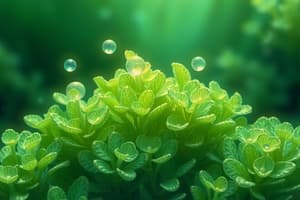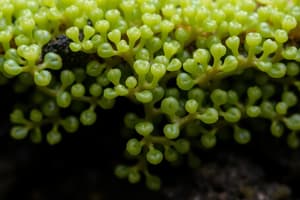Podcast
Questions and Answers
What is the composition of the cell wall in Chlorophyta?
What is the composition of the cell wall in Chlorophyta?
- Cellulose (correct)
- Chitin
- Pectin (correct)
- Lignin
Chlorophyta can only reproduce sexually.
Chlorophyta can only reproduce sexually.
False (B)
What pigments are found in Chlorophyta?
What pigments are found in Chlorophyta?
Chlorophyll a and b, beta-carotene, and xantophylls.
Name one economic importance of Chlorophyta.
Name one economic importance of Chlorophyta.
Which order includes the genus Chlamydomonas?
Which order includes the genus Chlamydomonas?
The classification of Chlorophyta includes unicellular organisms only.
The classification of Chlorophyta includes unicellular organisms only.
Chlorophyta primarily inhabit __________ and __________ environments.
Chlorophyta primarily inhabit __________ and __________ environments.
Which genus is known for being a good source of protein?
Which genus is known for being a good source of protein?
What type of reproduction occurs in Ulothrix?
What type of reproduction occurs in Ulothrix?
Match the following genera with their descriptions:
Match the following genera with their descriptions:
Flashcards are hidden until you start studying
Study Notes
CHLOROPHYTA (Green Algae) Characteristics
- Covered by a cell wall composed of cellulose and pectin.
- Contain pigments such as chlorophyll a, chlorophyll b, β-carotene, and xanthophylls.
- Store food reserves in the form of starch.
- Reproduce both sexually (isogamy, anisogamy, oogamy) and asexually (via akinetes, aplanospores, and zoospores).
- Found in various habitats, including aquatic (both fresh and marine) and terrestrial environments.
Economic Importance
- Serve as food sources for humans and livestock.
- Contribute significantly to oxygen production.
- Used in sewage treatment processes.
- Contain crude oil reserves in the seabed.
- Genus Chlorella is a notable protein, fat, and carbohydrate source.
Classification
Class Chlorophyceae
- Includes unicellular and multicellular organisms.
- Lacks transverse whorls of branches along a central filamentous axis.
- Comprises approximately 425 genera and 6,500 species.
Order Volvocales
- Features motile, flagellated vegetative cells.
- Sexual reproduction varies between unicellular (division) and colonial (colony division).
- Asexual reproduction involves isogamy, anisogamy, and oogamy.
- Families include Chlamydomonadaceae (e.g., Chlamydomonas) and Volvocales (e.g., Volvox).
Order Ulotrichales
- Consists of cells united in simple or branched filaments.
- Thallus differentiated into prostate and erect portions.
- Sexual and asexual reproduction via zoospores (biflagellate or quadriflagellate).
- Families include Ulothrix and Protococcaceae (e.g., Protococcus).
Order Cladophorales
- Features multinucleate or coenocytic cells with reticulated chloroplast.
- Asexual reproduction through quadriflagellate zoospores and akinetes.
- Includes families such as Cladophoraceae (e.g., Cladophora) and Pithophora.
Order Oedogoniales
- Characterized by cylindrical, uninucleate cells with reticulate chloroplasts.
- Asexual reproduction produces zoospores; sexual reproduction is oogamous.
- Family Oedogoniaceae includes the genus Oedogonium.
Order Zygnematales (Conjugales)
- Gametes are amoeboid and non-flagellated.
- Cells can be solitary or form unbranched filaments.
- Sexual reproduction occurs through isogamy.
- Includes families like Zygnemataceae (e.g., Spirogyra, Zygnema) and Desmidiaceae (e.g., Cosmarium, Closterium).
Order Chlorococcales
- Lacks vegetative cells; aplanospores are produced as non-flagellated spores.
- Reproduces sexually through isogamy, anisogamy, or oogamy.
- Families encompass Chroococcaceae (e.g., Chlorococcum), Oocystaceae (e.g., Chlorella), and Scenedesmaceae (e.g., Scenedesmus).
Macroalgae Orders
Order Siphonocladales
- Thalli are anchored by rhizoids.
- Asexual reproduction through quadriflagellate zoospores; sexual reproduction may be isogamous or oogamous.
- Family Valoniaceae includes the genus Valonia.
Order Dasycladales
- Thalli possess an erect central axis with branch whorls.
- Contains a single diploid nucleus.
- Family Dasycladaceae includes genera Acetabularia and Halicoryne.
Order Ulvales
- Thalli can be sheets, tubes, or solid cylinders.
- Asexual reproduction through quadriflagellate zoospores; sexual reproduction can occur by isogamy or heterogamy.
- Includes families like Ulvaceae (e.g., Ulva, Enteromorpha).
Order Siphonales
- Characterized by a single branched multinucleate thallus.
- Sexual reproduction includes isogamy, anisogamy, and oogamy.
- Family Caulerpaceae includes the genus Caulerpa and other related genera.
Class Charophyceae
- Known as stoneworts with erect branched thalli formed of regular nodes and internodes.
- Sexual reproduction is oogamous, involving one-celled oogonia.
- Genus Chara is recognized for its watery “meadows” and high chlorophyll content, giving it a vibrant green color.
Studying That Suits You
Use AI to generate personalized quizzes and flashcards to suit your learning preferences.




